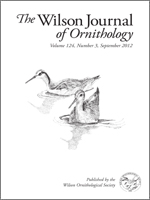Geographic relocations of migratory passerines have shown that adults can compensate for physical displacements; juveniles on their first migration, however, use an innate clock-and-compass strategy and are unable to compensate for displacement. We examined the effects of changes in magnetic inclination and intensity on orientation of adult and juvenile Australian Silvereyes (Zosterops l. lateralis) to learn if geomagnetic cues are used by a migratory passerine for geographic positioning. Silvereyes, captured in breeding areas in Tasmania, were physically transported to a location along their migratory route and assessed for orientation during autumn migration. Adults and juveniles exhibited seasonally appropriate, northeasterly orientation (19° and 23° east of magnetic North, respectively) when tested under the natural geomagnetic field. Birds were then exposed to changes in the magnetic field that simulated either southern (SimS) or northern (SimN) locations near the beginning and end, respectively, of their migratory route. Inexperienced juveniles continued to show seasonally appropriate orientation (3° and 358°, respectively) in both SimS and SimN magnetic fields. Adults, in contrast, exhibited changes in orientation but only when the experimental magnetic field was consistent with a geographical displacement that should require compensatory orientation (i.e., SimN). Adults exposed to a SimS magnetic field continued to show seasonally-appropriate orientation to the North (0°). However, adults exposed to magnetic fields simulating locations beyond their wintering areas (SimN) altered their orientation significantly, orienting bimodally and perpendicular (123°–303°) to their seasonally appropriate migratory direction. These results are consistent with the presence of an age- or experience-dependent magnetic geographic position sense in migratory Australian Silvereyes.
How to translate text using browser tools
1 September 2012
Age-Dependent Orientation to Magnetically-Simulated Geographic Displacements in Migratory Australian Silvereyes (Zosterops l. lateralis)
Mark E. Deutschlander,
John B. Phillips,
Ursula Munro
ACCESS THE FULL ARTICLE





